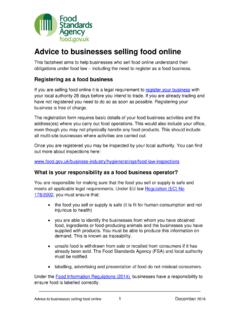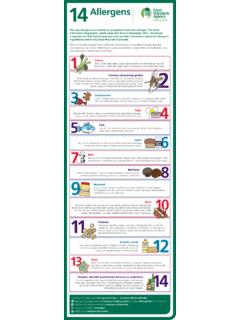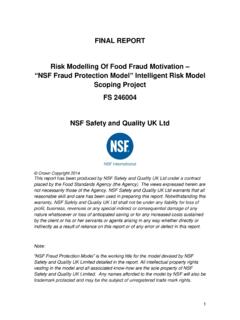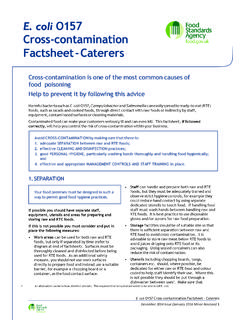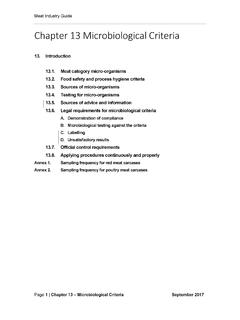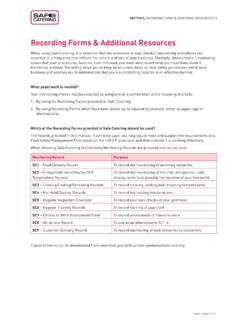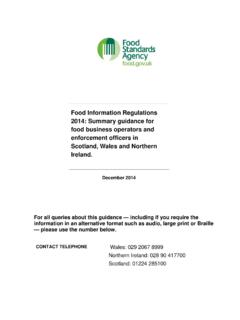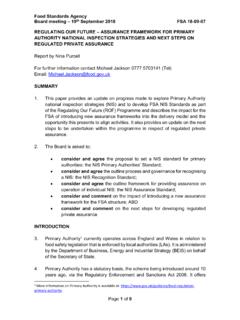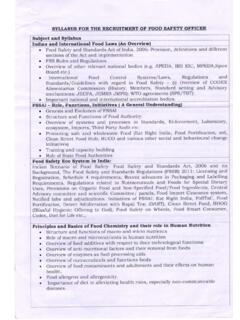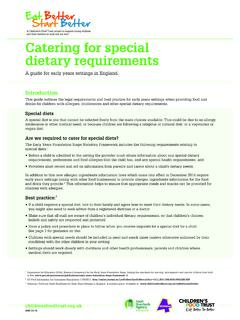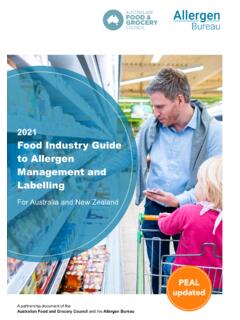Transcription of Chapter 9 HACCP - Food Standards Agency
1 Meat Industry Guide Page 1 | Chapter 9 HACCP September 2017 Chapter 9 HACCP1 9. Introduction HACCP principles Flexibility in implementing HACCP principles Good hygiene practices (GHP) Generic plans Legal requirements for HACCP A. HACCP based procedures B. Application of HACCP principles C. Review of HACCP -based procedures D. HACCP training Official control requirements Annex 1. CCP decision tree 1 Hazard analysis and critical control point ( HACCP ) Meat Industry Guide Page 2 | Chapter 9 HACCP September 2017 9.
2 Introduction All food business operators are responsible for making sure that the food produced by their business is safe to eat (Regulation (EC) No 178/2002 Article ). This means that it is neither injurious to health nor unfit for human consumption. To do this, Regulation (EC) 852/2004 Article 5 requires the operator to put in place, implement and maintain permanent procedures based on HACCP principles. To produce safe food for consumers, all the important safety hazards that are associated with the production of food need to be prevented, eliminated or reduced to an acceptable level.
3 These food safety hazards may be biological, physical or chemical see Chapter 1 Introduction . Meat Industry Guide Page 3 | Chapter 9 HACCP September 2017 HACCP principles The seven hazard analysis and critical control point ( HACCP ) principles provide a systematic way of identifying food safety hazards, making sure that they are being managed responsibly and showing that this is being done continuously. In short this involves the following steps: Plan what needs to be done to maintain food safety and write it down. Do what you planned to do to maintain food safety.
4 Check that you are doing what you planned to do to maintain food safety and write down what was checked and when. Act to correct any food safety problems and write down what has been done about the problem and when. The 7 HACCP principles are: 1. Identify any hazards that must be prevented, eliminated, or reduced to acceptable levels. 2. Identify the critical control points (CCPs) at the step or steps at which control is essential to prevent or eliminate a hazard or to reduce it to acceptable levels. 3. Establish critical limits at CCPs which separate acceptability from unacceptability for the prevention, elimination or reduction of identified hazards.
5 4. Establish and implement effective monitoring procedures at CCPs. 5. Establish corrective actions when monitoring indicates that a CCPs is not under control. 6. Establish procedures, which shall be carried out regularly, to verify that the above measures are working effectively. 7. Establish documents and records commensurate with the nature and size of the food business to demonstrate the effective application of the above measures. EU food hygiene legislation requires food business operators to establish, implement and maintain a food safety management system based on the seven HACCP principles (Codex Alimentarius document CAC/RCP 1-1969, rev.)
6 4-2003 available at: ). Documentation is an important part of a HACCP -based system and may be kept in the food safety management diary for meat producers available from the FSA website at: and on the FSS website at: Flexibility in implementing HACCP principles (EC guidance 16/11/05) In food businesses involving no preparation, manufacturing or processing of food (for example, grocery shops or the storage and transport of pre-packed food at ambient temperature), hazards may be controlled through good hygiene practices alone. Meat Industry Guide Page 4 | Chapter 9 HACCP September 2017 Where food is prepared, manufactured or processed operators can develop their own food safety management procedures by following a traditional HACCP , or by following guides to good practice, including generic HACCP guides.
7 Documentation is an important part of the HACCP process as it provides evidence of the operator s thinking and decisions that can be audited. However, flexibility includes the possibility of exception reporting of visual monitoring checks. This means making a record only when there is such a problem or something unusual happens and recording the corrective action taken as a result see B8. to B9. Documentation . Good hygiene practices (GHP) It is vital that food business operators have reliable hygiene procedures in place before starting to apply HACCP principles.
8 management of food safety is achieved by a combination of good hygiene practices (also called prerequisite procedures) and operational procedures based on HACCP principles. HACCP -based procedures for controlling hazards throughout food production will not be effective unless good hygiene practices are also being followed. GHPs are set out in Regulation (EC) 852/2004 and are covered in chapters on Water supply , Maintenance , Temperature controls 2, Cleaning , Traceability3, Pest control , Wrapping, packaging and transport hygiene , Personal hygiene , Waste management and Training.
9 Generic HACCP guides Meat production is similar enough across the industry to justify a generic approach for implementing HACCP principles. This approach helps to provide uniformity in training, implementation, and enforcement but cannot reflect the individual features of each plant and how it operates. Thus, if generic guidance is followed operators need to adapt it to reflect their own circumstances. For further information and the food safety management diary for meat producers please see: 2 Temperature controls can also be CCPs (EC Guidance Annex II point 10).
10 3 Traceability can be considered to be a prerequisite (EC Guidance Annex II point 5). 0 HDW ,QGXVWU\ *XLGH 3 DJH _ &KDSWHU +$&&3 6 HSWHPEHU /HJDO UHTXLUHPHQWV IRU +$&&3 7KH IROORZLQJ VHFWLRQV VHW RXW WKH UHTXLUHPHQWV RI WKH K\JLHQH UHJXODWLRQV IRU DSSO\LQJ +$&&3 SULQFLSOHV WR WKH VODXJKWHU DQG IXUWKHU SURFHVVLQJ RI PHDW $ +$&&3 EDVHG SURFHGXUHV $ &RPSOLDQFH UHJDUGLQJ WKH +$&&3 EDVHG SURFHGXUHV x 3XW LQ SODFH D SHUPDQHQW SURJUDPPH RI SURFHGXUHV WR PLQLPLVH IRRG VDIHW\ KD]DUGV DQG SURGXFH IRRG VDIHO\ $ *RRG SUDFWLFH +$&&3 FHUWLILFDWLRQ 7 KHUH LV QR UHTXLUHPHQW IRU +$&&3 SURFHGXUHV WR EH FHUWLILHG IRU H[DPSOH XQGHU TXDOLW\ DVVXUDQFH VFKHPHV $Q\ VXFK LQLWLDWLYH LV D EXVLQHVV GHFLVLRQ 0 DQDJHPHQW FRPPLWPHQW 6 XFFHVVIXO LPSOHPHQWDWLRQ RI +$&&3 EDVHG SURFHGXUHV GHSHQGV RQ WKH FRPPLWPHQW RI FRPSDQ\ PDQDJHPHQW.
